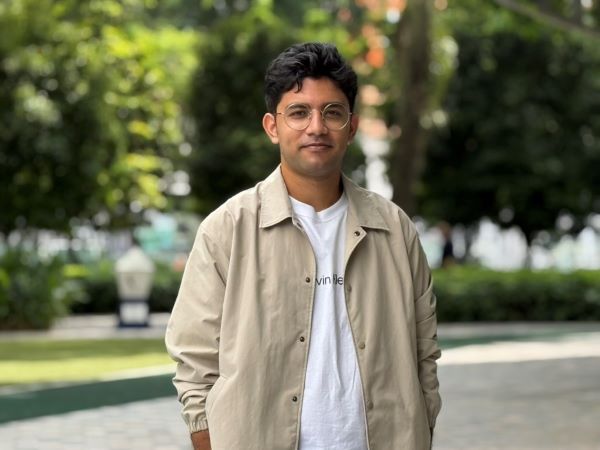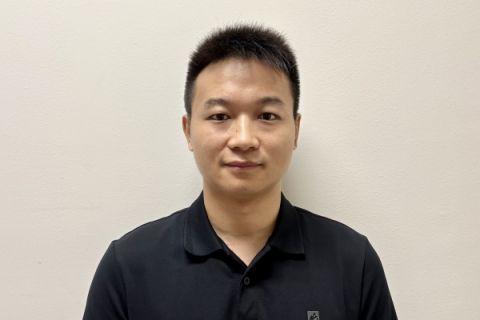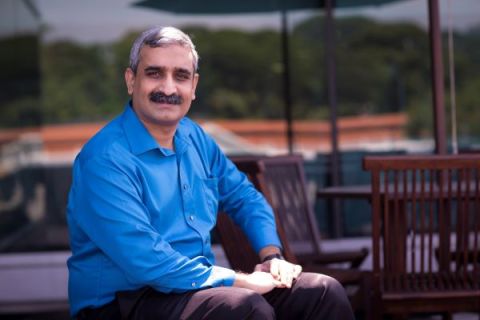
By Christie Loh
SMU Office of Research – When his parents heard that he had won an award at his workplace, they were naturally delighted, showering their son with a confetti of questions like what the prize was for, whether there was a formal ceremony, and that he must keep up the good work. Indeed, Monit Sharma is well aware that as encouraging as the SMU Research Staff Excellence Award is, the professional road he is on calls for both hard work and stamina.
The 23-year-old is a Research Engineer at SMU’s School of Computing and Information Systems (SCIS), and among the campus’s handful of researchers focused on quantum computing. That is a topic that befuddles most – while singing to the hearts of an elite few like Sharma, who received the research award – which recognises “significant contributions by outstanding members of our research staff community who worked alongside our faculty to conduct high quality research that additionally creates positive impact on our society” – within two years of joining the university.
In late 2022, Sharma left his home country of India for Singapore after successfully applying for the SMU research position. He knew of the opening only because SMU’s Professor of Computer Science Lau Hoong Chuin had emailed him out of the blue after reading his postings on GitHub, a web-based platform for users to share code and collaborate. At the time, Sharma had graduated just a few months from the Indian Institute of Science Research Education, Mohali, with a dual Bachelor’s and Master’s Degree in Physics. Coupled with his minor in Mathematics and in Computer Science, he could wrap his head around quantum computing and enter the buzzing industry.
Quantum for the real world
Governments and tech companies have been pouring billions of dollars into quantum computing since the 1980s when the technology involving ultra-tiny complex devices called qubits promised ultra-fast processing speeds that can trump even the best classical (that is, non-quantum) supercomputers. That kind of power is expected to be able to solve complex problems related to all facets of living, including the environment, medicine, finance and logistics. It is this dazzling potential that has triggered a race among tech companies and governments to build a quantum computer that is stable enough to perform meaningful tasks like classical computers can. That is the hardware side. Concurrently, those on the software side are crafting algorithms for quantum computers.
In Sharma’s case, he has been trying to use quantum algorithms to solve real-world supply chain issues. His findings were published last year in two papers that were presented at a top quantum conference. A third paper, which studied inventory management, incorporated actual data provided by IBM Manufacturing Solutions Singapore to find out the quantity of parts it should order from each supplier based on their respective reliability. This study’s quantum algorithm results were closely aligned with a classical optimisation method, thereby validating quantum computing’s practical applicability.
“All this work is like proof of concept,” Sharma, who was the lead author for the three papers in collaboration with Professor Lau, said in an interview with the Office of Research. They plan to submit the third paper, which is titled “Quantum Monte Carlo methods for Newsvendor problem with Multiple Unreliable Suppliers”, for publication this year.
QEP2.0
Work on all three papers was carried out as part of the Singapore National Research Foundation’s (NRF) Quantum Engineering Programme (QEP) 2.0. Under this scheme, a grant was awarded to SMU via the National Quantum Computing Hub for a two-year project titled “Optimizing Supply Chain Resilience with Quantum Sampling”. The need to strengthen supply chain capabilities came to the fore with the Covid-19 global outbreak, and quantum computing has been hailed as a major tool for simulating complex what-if scenarios and minimising cost and risk.
Sharma found the experience of working on the QEP2.0 project “incredibly rewarding”, as he had the opportunity to collaborate with renowned researchers in the field: One was Dr Rudy Raymond, who was Quantum Researcher at IBM when he co-authored two of the papers with Sharma and has since joined JPMorgan Chase as Executive Director of its Global Technology and Applied Research division; and Dr Stefan Woerner, Principal Research Scientist and Manager of Quantum Computational Science at IBM Research Europe – Zurich.
On home base, Professor Lau was “an excellent mentor throughout the project”, providing his guidance and expertise in Operations Research, said Sharma.
The reality of quantum’s readiness
On most days of the week, you will find Sharma in the SCIS block within a quiet room divided up by grey desk partitions, sharing the open-plan workspace with doctoral students and other researchers. He is the one at the end of the row near the glass windows, with two computer screens on a tabletop with no clutter save a few anime figurines. That is where he writes code and runs quantum algorithms on a Cloud platform. And where he has seen first-hand that for all its dazzling potential, quantum computing at present is not yet able to tackle real-life, large-scale scenarios.
“I think it will take at least two decades for the hardware to be at a good level so that you can at least test decent-sized problems,” he said.
In Sharma’s test runs of quantum versus classical algorithms, it has been classical computing that consistently comes out tops. Sharma will be formalising his comparative study in an upcoming paper, where he uses the best quantum algorithms produced so far by the community and himself to solve benchmark problems that have been proven to be hard to solve by classical computing, and then comparing his results with classical results.
He also believes in being open to the possibility of using “hybrid solutions” that incorporate the best parts of both classical and quantum computing.
Sharma has what he calls a “pragmatic outlook” on quantum’s capabilities.
“I think it's critical to focus on incremental progress, communicate responsibly about what quantum can and cannot do today,” he said. “Achieving quantum advantage – or more ambitiously, quantum supremacy for practical tasks – is a marathon, not a sprint.”
Back to Research@SMU February 2025 Issue
See More News
Want to see more of SMU Research?
Sign up for Research@SMU e-newslettter to know more about our research and research-related events!
If you would like to remove yourself from all our mailing list, please visit https://eservices.smu.edu.sg/internet/DNC/Default.aspx

